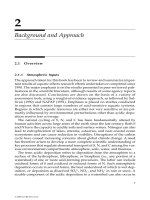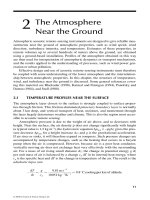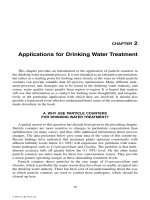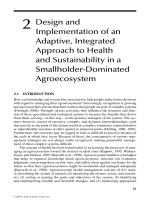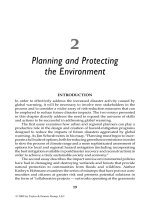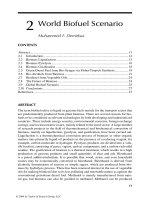BRINGING FARMERS BACK INTO BREEDING - Chapter 2 potx
Bạn đang xem bản rút gọn của tài liệu. Xem và tải ngay bản đầy đủ của tài liệu tại đây (87.93 KB, 5 trang )
14
Food policy arguments
• It is estimated that a two- to three fold increase in production is required to meet global food
demand in the next 30 to 50 years. It is by no means clear how this will be achieved .One obvious
contribution to this target is to more fully exploit the potentials of marginal areas and a whole
range of minor crops. This has the particular benefit of increasing food production in areas where
food is much needed.
Environmental arguments:
• Farmer seed systems are a major source of the remaining agrobiodiversity that exists in situ. This
agrobiodiversity is a major source of genetic diversity with direct relevance to local adaptation and
meeting divers farmer/consumer requirements. Ensuring that farmers’ retain control over, and
access to, such genetic resources requires in situ conservation systems.
2 METHODOLOGIES
The plant breeding methodology is well established. It involves setting breeding objectives, generating
the required genetic diversity through hybridisation, recombining the first generations, followed by
various forms of selection in subsequent generations to increase the frequency desired characteristics and
to fix these, leading to a new variety that is reasonable uniform and stable. Hence, the question in PPB is
not so much what to do, but how to involve new partners in the breeding process. Technically this is
determined by the relative comparative advantages of plant breeders and farmers and the role of other
brokers, often NGOs, who act as facilitators. However, in practice, the roles that various partners are
willing and able to play are not always straightforward. As yet, there is no consensus among plant
breeders about the advantages of farmers’ active participation in the various stages of breeding and on-
farm selection or the extent to which farmers should be affording responsibility and ownership of the end
product. It may seem logical to have farmers set their own breeding objectives and this often accords
with the agenda of facilitating NGOs who also seek to empower farmers. This approach may at times
however conflict with what may seem to be the most technically effective approach. Finally, farmers may
be guided by an interest in specific activities for which they may not necessarily have a comparative
advantage. This creates a range of arrangements in which the various actors organise themselves for
carrying out PPB. Since the procedures and methods used relate to the form that cooperation between
breeders and farmers takes, we distinguish between the social and technological components of PPB.
Broadly speaking, the technical component relates to the actual breeding procedures, while the social
component refers mostly to the way the actors interact.
2.1 The technical component
Public and private plant breeding generally stress broad adaptability to maximise the range of
environments in which their varieties can be adopted. Potential new varieties are commonly tested in
multi-locational experiments prior to their release. In the final selection of varieties for release, including,
when appropriate, application for protection of Plant Breeders’ Rights (PBR) and satisfying the rules and
regulations for market distribution, the varieties that are usually most favoured are those that do well over
a range of sites/environments. Hence, varieties that exhibit high local specificity tend to be excluded.
From the economic point of view this is understandable.
However, plant breeders are increasingly faced with GxE interactions outside the range that can be
adequately covered by broad adaptability. Hence, local specificity becomes more of an issue when
addressing the needs of more diverse marginal environments. The problems are exacerbated by the
conditions of low-input farmers in such regions, who often lack the means to correct the vagaries of the
environment through use of external inputs such as irrigation and agrochemicals. This has led to various
forms of "decentralised" selection (see box 2).
15
The advantages of involving farmers in on-farm trials in the breeding process and in setting breeding
objectives to suit their requirements are generally recognised. Witcombe et al. (2006) argued that PPB
merely refers to increasing levels of "client-orientation" in plant breeding and suggests that the division
between 'participatory' and 'non-participatory' breeding is artificial. They suggest the term 'Client-
Oriented Breeding’ (COB), and argues that this should be based on a rigorous examination of why and
when farmers should be involved in the plant breeding process" (Witcombe et al., 2005). In their opinion
better adapted varieties can, from a purely technical point of view, be developed without necessarily
involving farmers selecting material on their own farms during segregation generations. This view is
supported by Morris and Bellon (2004) who suggest that the most efficient way to involve farmers in the
breeding process could be to limit their involvement to goal setting and testing final varieties. Weltzien et
al. (2003) draw similar conclusions from reviewing a number of cases, pointing towards the possibly
unnecessary complexity introduced by farmer participation.
On the other hand, there are important arguments for involving farmers in the intervening phases of
selection. Farmers are considered to be in a better position to observe and evaluate complex trait
combinations that are relevant in their own farm conditions – often resulting in other characteristics being
taken into consideration which plant breeders would not have used. In support of this, Sperling et al.
(1993) reported cases where, in later generations, farmer selections out-yielded those made by breeders.
Gyawali et al. (2002) and Joshi et al. (2002) found that farmers preferred the selections made by other
farmers not because of higher yields, but because they combined comparable yield with earlier maturity.
Kornegay et al. (1996) pointed out that farmer selection sometimes had the advantage of combining
reasonable yield with better quality, resulting in higher market prices. Similar experiences, in which
farmers combine high yields with preferred consumption traits are reported by Bertuso et al. (1995), as
well as by authors of case studies presented in this document. For farmers these other traits (more than)
compensate for possibly lower yields. For the same reasons, landraces are often preferred over higher
yielding modern varieties, notably in rice in many Asian countries (personal observation).
A related theme is the growing concern, often expressed by NGOs, about the effects of institutionally
bred, genetically uniform, modern varieties on farmer seed systems, as this was leading to genetic erosion
and creating dependency and loss of ownership of farmers over their planting materials. They stressed the
importance of farmer seed systems as a reliable, robust and major source of seeds especially for poor
farmers and highlighted the need to protect farmers’ ownership and control over the genetic resources
which they have nurtured, and on which they depend. With some justification, they view farmers as self
reliant and competent in selecting and managing genetic diversity. Their basic is objective to empower
farmers and farmer seed systems. Initially, this position led to a confrontational attitude towards formal
plant breeding, national seed supply systems and ex situ conservation.
It is worth examining the different perspectives that these positions entail. The first stresses maximum
efficiency in breeding and the supply of new varieties through institutional seed systems, the latter
attempts to combine effective plant breeding with increasing the role of farmers in the breeding process,
safeguarding their ownership and diffusing the products through farmer seed systems.
B
ox 1.2 Decentralisation and participation
This approach was pioneered by Ceccarelli et al. (2001) in the ICARDA barley breeding
Programme which addressed diverse environments in the Middle East and North Africa. He
refers, to such cases as decentralised
b
reeding. On the basis of the level of farmer involvement in
selection, he differentiates between:
• Selection by farmers in their own fields (decentralised participatory selection)
• Selection on the research station by farmers (centralised participatory selection)
• Selection by breeders in farmers' fields (decentralised non-participatory selection)
• Selection by breeders in the research station (centralised non-participatory selection).
Despite these differences there is a common factor in that all these approaches lead to final
p
roducts of a breeding programme, namely the finished varieties that are named by the breeding
institution (thus claiming a form of ownership) and that satisfy standards (such as distinctness,
uniformity and stability) necessary to gain entry to the institutional seed supply system.
16
It is interesting to observe that in the evolution of, what is variously referred to as PPB, PCI, De-
centralised Breeding or Client-Oriented Breeding, there has been an increase in understanding between
these two, somewhat polarised positions. Many plant breeders, through working with farmers, have
become aware of the advantages of involving farmers in the breeding process. At the same time, NGOs
confronted with the complexities of plant breeding and the value of modern varieties as a source for high
production potential recognised the benefits that plant breeders and formal institutions could render in a
supportive role. This coming together is not only apparent between projects, but even in developments
within projects. However, for this to occur within programmes it is essential that plant breeders and
farmers share common interests and goals and that the breeding programmes last sufficiently long for
such for changes in the process to occur.
2.1.1 Participatory Variety Selection (PVS)
Participatory Variety Selection (PVS) is the first step in increasing the role of farmers in the crop
improvement process. There is little doubt about the advantages of involving farmers in testing potential
new varieties either on-station or on-farm. This process also provides breeders with information about the
specific requirements of farmers, thereby helping to set breeding objectives. PVS involves testing and
selecting new varieties developed by the institutional system within farmers' fields and at local research
stations in various environments and allowing farmers to compare these varieties with local farmer
varieties. A variant of this practice was already commonly adopted in commercial plant breeding to
demonstrate the performance of a new variety to potential markets. This form of testing new varieties is
also widely practiced by the international institutes of the CGIAR, largely in cooperation with National
Agricultural Research Systems (NARS). However, in comparison with such, essentially promotional,
activities PVS generally tests a larger number of varieties. Farmer varieties are included not only as
controls, but also as possible alternatives, and these may also include farmer varieties from other
localities. The main objective is to provide farmers with a wider and unbiased range of options to
independently choose from. This re-establishes the prerogative of farmers to make their own choices, one
that was undervalued in the early years of the "Green Revolution" in many countries. Its general
empowering effect should not be underestimated.
2.1.2 Participatory Plant Breeding (PPB)
The concept of PPB (in its narrow meaning) is a logical extension of PVS, though less straightforward. In
conventional plant breeding, parents are selected and crossed to produce the F1. Usually over the next 2-
3 generations the main objective is the recombination of the characteristics of both parents and only mild
(negative mass) selection is practiced. From a breeding point of view the involvement of farmers at this
stage seems to offer few advantages. In addition, and especially in F1 hybrids, there is only a small
number of seeds, which have a high value. Planting these seeds in farmers’ fields is therefore felt to be
risky, as conditions are less controlled and seeds may more easily be lost. Major selection for local
adaptation (soils, prevailing diseases, drought, temperature etc.) and farmers' requirements (taste,
appearance, storage ability etc.) usually starts in the third and more often the fourth generation. It is at
this stage that PPB starts to offer real advantages. This however relies on the assumption that research
establishments are capable and willing of producing appropriate breeding populations for the target
environments. This has not always proved to be the case. Hence, at present, many farmers interested in
PPB face the problem of how to obtain suitable breeding populations.
Starting/breeding populations
An important technical issue raised by PPB is how to develop starting materials.
The most common approaches taken in PPB are:
• Improvement of local landraces through forms of mass selection in cross pollinating crops and
combined with line selection in self pollinating crops
• Crossing favoured local landraces with modern high yielding varieties, either by research or by
farmers themselves.
Farmers are well placed to take responsibility for the improvement (rehabilitation) of local landraces and
this is generally considered a fairly straightforward activity. Selection of seed for next season’s planting
is also a form of PPB. It is most effective in cross-pollinating crops and can be readily adopted by
individual farmers. This is not so very different from the selection of plants in later generations of
breeding. In self pollinating crops, like rice, local landraces are improved by occasionally practicing line
17
selection. This more usually occurs as a collaborative activity within communities with farmers sharing
the results.
In both cross and self pollinating crops attention has to be given to achieving the appropriate selection
intensity. This requires proper seed production practices, involving pre- and/or post harvest selection
prior to harvesting the seed for the next planting season.
Hybridisation
Development of breeding populations generally involves identifying suitable parents for hybridisation
followed by inter-crossing these materials. The most common practice is to cross (selected) plants from
favoured local landraces with modern high yielding varieties particularly (if available) those that already
demonstrate a reasonable degree of local adaptation. If not available, research institutes can be consulted
as they have access to a wider range of potential parent materials. The objective is to maintain the
preferred characteristics of the local material, combining these with the higher yield potential of the
modern variety. Farmers can be trained in crossing techniques, although the ease of crossing differs
between crop species. In maize it can be realised easily by inter-planting both parent materials and
detasseling. In self-pollinating species it requires emasculation of maternal parents and hand pollination
with the pollen of the paternal parent. The actual crossing generally offers few problems. The number of
hybrid seeds harvested is generally small and they need to be carefully harvested and stored. Crossing is
a laborious activity which research stations are arguably better placed to take care of. On the other hand,
individual farmers, with proper training, are often interested in crossing as this increases their sense of
ownership.
An important aspect in which farmer managed PPB tends to differ from institutional breeding and
institutional controlled PPB is the number of crosses made and the number of breeding populations
tested. Farmer managed PPB usually starts with crossing one or only a few preferred local varieties with
an available improved High Yielding Variety (HYV). The objective is to combine the established
preferred characteristics of the local variety with higher yield potential of the HYVs. Hence only a
limited number of crosses and cross-combinations are made. In institutional breeding the number of
crosses between different materials is much larger (often exceeding 50), both within specific parental
materials and in combinations between different parental materials
Recombination
Often starting from a limited number of seeds, recombination in the first generations requires secure
growing conditions. Thus research stations can again offer better facilities than small farmers. Farmers
may start selection too early in already narrow genetic diversity and thereby narrow the range of genetic
variation available in later generations. This problem can be addressed by sufficiently detailed training.
Selection
The effectiveness of selection in more advanced generations is determined by the ability of farmers to
recognise those plants within a population that most closely suit their requirements. Their ability to do so
is obvious. Important factors of continued success are the selection intensity and ensuring that all the
preferred characteristics are maintained in the next generation. This requires some initial guidance and
training. However, it does not necessarily require strict adherence to the protocols and experimental lay-
out that are commonly employed in institutional breeding. It is also true that success in institutional
breeding is largely dependent on the ability of an individual breeder to recognise good plants within a
segregating population rather than just relying on statistical analysis.
2.2 The social component
Farmer participation can be enhanced in different ways and this largely depends on the respective roles of
the various partners involved. Following the typology set out by Biggs (1989) of approaches to
improving user perspectives in research, cooperation in PPB between plant breeders and farmers may
range from consultative to contractual to collaborative and finally to collegial. Different forms are:
• Breeders can consult farmers in order to set more realistic goals and choose more appropriate
parents
• Farmers can be consulted by evaluating material grown on (local) research stations
18
• Farmers can collaborate with plant breeders by growing and selecting (in/between) breeding
materials for various stages of the breeding process in their own fields
In this process, plant breeders essentially still retain full control of decisions and materials and
orchestrating the programme, with an essentially consultative involvement from farmers.
This level of engagement can be augmented by additional forms of collaboration, which involve farmers
more actively: such as supplying farmers with segregating breeding materials from appropriate parents in
various stages of development for further on-farm variety development (collegial). Finally, farmers may
be in full control, managing all phases of the breeding process, with plant breeders merely acting as
trainers and advisers. This can result in for example the following types of situation:
• Farmers are trained to make crosses, often involving high yielding modern varieties and preferred
local materials and, with some guidance from plant breeders, can develop new varieties.
• With some training in selection and seed production farmers can rehabilitate and maintain their
local varieties through selection.
The above represents a sliding scale in the process of breeding that is controlled by plant breeders to
increasing involvement of farmers. Increasing farmer involvement assumes that they will exert more
influence on the materials to be selected and advanced to a next generation and where (and how) the
evaluation takes place.
PPB can be practiced by individual farmers. However in general, and in the cases presented here, it is
initiated by either national research or by NGOs acting as facilitators and trainers in specific projects. It
tends to require community action, if only because it usually involves farmers with small holdings. The
organisation of these communities and of the programmes can vary considerably
Projects initiated by plant breeding institutions, often start in response to low adoption rates of the new
varieties and mostly use farmers in a consultative function. Hence they are primarily concerned with
identifying communities and farmers in specific environments that will test breeding materials under the
guidance of plant breeders. This process also increases plant breeders’ understanding of farmers’
requirements.
By contrast, projects initiated by NGOs often have an explicit aim of empowering farmers. Hence they
tend to start from forms of community development. In Central America this often takes place by
identifying groups of farmers and providing some form of group organisation (e.g. Local Agricultural
Research Committees - CIALS). These groups act as counterparts for supporting institutions. In South
East Asia the Farmer Field School methodology, developed initially for Integrated Pest Management
(IPM), is widely used (Ngo Tien Dung and SEARICE, 2003). It has been adapted by the CBDC, BUCAP
and PEDIGREA partners to the management of genetic resources and involves intensive group training
of farmers supported by staff of the institutions. Training in technical aspects continues throughout the
whole planting season. This approach has proven to be highly effective in Asia and has been rapidly
taken up by farmer communities. It increases the confidence of farmers and is changing their relationship
with research and extension services from one that is top-down to one that is more participatory.

